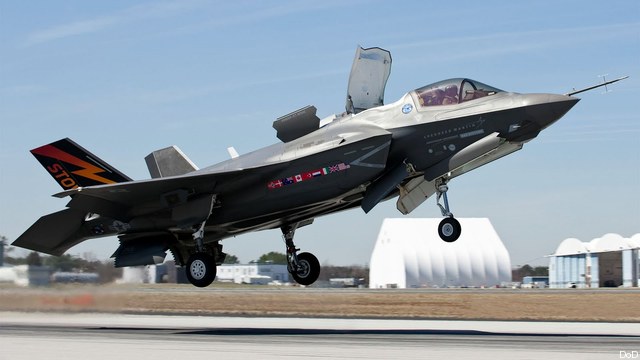FAIRFORD, UK: Lt. Gen. Chris Bogdan hates being labeled the man who oversees the trillion dollar jet fighter, also known as the Joint Strike Fighter as you can tell from the headline.
Breaking Defense readers will remember that this estimate is extends more than half a century and includes such assumptions as the Marines will fly the F-35 vertically or in hover much more frequently than they will horizontally.
Bogdan has bullied, wheedled, cajoled and enticed the companies who make the F-35 to cut those costs and to do a better job of communicating with him and the taxpayers about problems with the plane.
In fact, he told reporters today at a press briefing here where the Royal International Air Tattoo begins tomorrow, he spends almost as much time on the phone with Lorraine Martin, the woman who leads Lockheed Martin’s work on the F-35, and Bennet Croswen, who leads Pratt & Whitney’s work building the F135, the engine that powers the plane, as he does with his wife.
To bring down those huge estimated costs Bogdan has signed what Martin calls a “landmark agreement” with Lockheed Martin. In return for $85 million invested by Lockheed, Northrop Grumman and BAE Systems each of the next two years on cost saving measures, Bogdan has agreed to let the companies keep the profits from the money saved.
There is, of course, a catch. The companies must first prove that their investments saved money. Only then do they get the profits.
In return, Bogdan will reap savings estimated by Martin to be north of $8 billion over the program’s life, after adding up results from the 300-plus savings efforts Lockheed and its partners have identified.
On top of those savings — which should bring the price of an F-35 in line with existing fourth generation fighters, as Martin has promised before. That should mean an F-35 will cost about $80 million each by 2019.
Bogdan also renewed an old idea Lockheed has been kicking around for years — implementing what are called block buys to save money. It would allow the United States to join with allies and to buy F-35s at discounted prices, thanks to the larger numbers Lockheed would produce.
This approach, which gets around the requirement that Congress approve multi-year buys and that their cost savings exceed 10 percent. Many of America’s partners in the F-35 program budget on a multi-year basis as a matter of course and want both the cost decrease and the greater flexibility block buys would yield them.
One example offered by Martin: changing the material with which the canopy bowframe is made will reduce the price by an estimated $340,000. Throughout the fleet of 3,000 some planes that will save $31 million over life of program, Martin said. Add a few dozen of those together and the money starts to add up.
On the topical question of whether the Marine version of the F-35 would appear at RIAT or at Farnborough, Bogdan was carefully neutral while indicating he hoped the four planes would fly here from Naval Air Station Patuxent River as long as they were cleared for safe flight by NavAir.
“We won’t rush that decision by the air worthiness authorities but we will give them all the information we can about the incident,” Bogdan said.
PIlots are standing by and could take off immediately should the green light be given, he added.
While neither Bogdan nor Martin said so, they sounded pretty confident that the F-35Bs would be cleared for flight in time for the Farnborough Air Show, which begins Monday. Even though signs around Swindon, the biggest town near here, sported F-35 Debut logos in the upper right corner, it looks pretty unlikely the aircraft will arrive there in time for Saturday flights at the tattoo.
China’s new H-20 stealth bomber ‘not really’ a concern for Pentagon, says intel official
“The thing with the H-20 is when you actually look at the system design, it’s probably nowhere near as good as US LO [low observable] platforms, particularly more advanced ones that we have coming down,” said a DoD intelligence official.




























